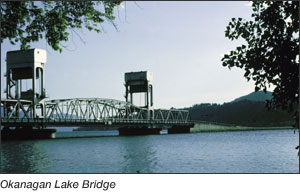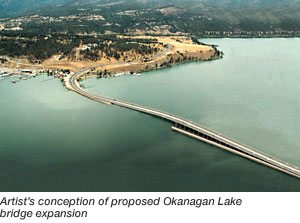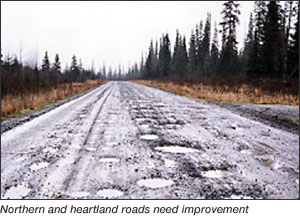 |
|
|
 |
 |
2003/04 – 2005/06 SERVICE
PLAN
Ministry of Transportation |
 |
 |
Resource Summary
| Core
Businesses |
2002/03
Restated Estimates1 |
2003/04
Estimates |
2004/05
Plan |
2005/06
Plan |
| Operating
Expenses ($000) |
| Highway Operations |
447,004 |
454,815 |
417,827 |
420,072 |
| Transportation Improvements
|
16,481 |
13,536 |
12,297 |
12,197 |
| Motor Carrier Regulation
|
595 |
1,804 |
1,610 |
1,610 |
| Public Transportation2 |
250,162 |
348,157 |
343,518 |
341,414 |
| Executive and Support Services
|
20,390 |
16,054 |
14,599 |
14,558 |
| Totals |
734,632 |
834,366 |
789,851 |
789,851 |
| Full-time
Equivalents (FTE) |
| Highway Operations |
1,103 |
964 |
602 |
602 |
| Transportation Improvements
|
340 |
290 |
280 |
280 |
| Motor Carrier Regulation
|
4 |
19 |
18 |
18 |
| Executive and Support Services
|
136 |
112 |
66 |
66 |
| Totals |
1,583 |
1,385 |
966 |
966 |
Ministry
Capital Expenditures
(Consolidated Revenue Fund) ($000) |
| Highway Operations |
4,140 |
5,150 |
2,543 |
4,888 |
| Transportation Improvements
|
1,350 |
974 |
595 |
575 |
| Executive and Support Services
|
2,375 |
326 |
1,275 |
1,050 |
| Totals |
7,865 |
6,450 |
4,413 |
6,513 |
| Other
Financing Transactions ($000) |
| Public Transportation |
155,070 |
46,390 |
5,560 |
4,190 |
| Revenue
($000) |
| Total Ministry Revenue3 |
46,989 |
47,816 |
48,889 |
50,049 |
BC Transportation Financing Authority — Consolidated Income
Statement1
|
|
2002/03
Budget |
2003/04
Budget |
2004/05
Plan |
2005/06
Plan |
| Revenue
($000) |
| Dedicated revenue2 |
203,200 |
418,300 |
430,500 |
443,000 |
| Capital contributions (amortization)3 |
181,054 |
174,808 |
171,145 |
165,270 |
| Contractor fees4 |
19,000 |
— |
— |
— |
| Other5 |
6,130 |
4,120 |
3,616 |
3,616 |
| Totals |
409,384 |
597,228 |
605,261 |
611,886 |
| Expenditures
($000) |
| Amortization |
280,736 |
287,528 |
297,127 |
306,453 |
| Financing expense6 |
154,119 |
160,479 |
176,679 |
188,783 |
| Contracted services |
— |
— |
— |
75,887 |
| Northern and heartland roads
|
— |
75,000 |
75,000 |
75,000 |
| Construction wages and benefits4 |
19,000 |
— |
— |
— |
| Operations and administration |
6,332 |
3,820 |
3,616 |
3,616 |
| Grant programs7 |
4,800 |
18,400 |
18,200 |
18,000 |
| Totals |
464,987 |
545,227 |
570,622 |
667,739 |
| Net
Income (Loss) ($000) |
| Net (Loss) Earnings
|
(55,603) |
52,001 |
34,639 |
(55,853) |
| Capital
(Consolidated Capital Plan) ($000) |
| Capital Expenditures
|
254,020 |
297,800 |
300,700 |
272,700 |
Rapid Transit Project 2000
|
|
2002/03
Budget |
2003/04
Budget |
2004/05
Plan |
2005/06
Plan |
| Revenue
($000) |
| Recognition of deferred
capital and pre-operating contributions |
34,321 |
27,457 |
27,457 |
27,457 |
| Expenditures
($000) |
| Amortization of deferred
capital contribution |
34,321 |
27,457 |
27,457 |
27,457 |
| Net
Income ($000) |
| Net Earnings |
— |
— |
— |
— |

Major Capital Projects
Under the Budget Transparency and Accountability Act, a
major project is defined as any capital commitment or anticipated
commitment that exceeds $50 million.
Project Name: Nisga’a Highway
Objectives:
To facilitate economic growth and development, the province is
continuing a seven-year investment program with two components:
- Upgrading the Nisga’a Highway to an all weather two-lane highway.
- Construction of the new Greenville to Kincolith road to open
up access to the Village of Kincolith. This project is financed
under a cost sharing partnership comprising the federal and provincial
governments and the Nisga’a Tribal Council.
Costs:
- The estimated total project cost for the Nisga’a Highway Upgrade
is $52 million.
- The estimated total project cost for Greenville-Kincolith (new
route) is $34.6 million ($17.5 million provincial share).
Benefits:
- Safety, access and mobility improvements.
- Increased economic development (e.g., tourism).
Project Name: Kicking Horse Canyon
Objectives:
The improvement program for the Kicking Horse Canyon involves upgrading
the 26-kilometre section of the Trans Canada Highway between Golden
at the junction of Highway 95 and the western boundary of Yoho National
Park to a modern four-lane standard. This investment would represent
a major service improvement to the Trans Canada Highway and is directed
at:
- responding to continual and severe safety problems;
- minimizing road closures due to slides and accidents;
- replacement of two major structures that are nearing the end
of their service lives;
- supporting the efficient movement of goods and services;
- facilitating trade and commerce;
- supporting tourism and associated local business opportunities;
and
- augmenting the capacity of a critical provincial/national gateway.
Costs:
The estimated capital cost of the improvement program is $730 million
(2002 dollars).
The upgrade will proceed in three phases:
5-Mile (Yoho) Bridge ($61 million): The project is being
cost shared with the Government of Canada under the Strategic Highway
Infrastructure Program (SHIP): $22 million federal and $39 million
provincial. Construction is in progress and forecast expenditures
to March 31, 2003 are $19.5 million.
10-Mile (Park) Bridge ($150 million): Cost sharing with
the Government of Canada is being pursued under the Strategic Infrastructure
Fund (SIF), with the objective of concluding a contribution agreement
in the near term and proceeding with implementation of the project.
Project development activity is in progress and forecast expenditures
to March 31, 2003 are $2.7 million. Financing and project delivery
options through a public-private partnership are being investigated.
Golden to 5-Mile and 10-Mile to Yoho National Park ($520 million):
Implementation is not proposed during the current three-year service
plan and would be subject to securing cost sharing with the Government
of Canada.
Benefits:
- The net present value of the 5-Mile (Yoho) Bridge and 10-Mile
(Park Bridge) sections is $110 million based on safety, travel
time, reliability and economic development benefits.
Risks:
- Technical Risk: Rock and slope stability and climatic conditions.
- Financial Risk: Possible construction problems due to difficult
topography and material costs.
- Availability of federal funding.
Project Name: Okanagan Lake Bridge

Objectives:
- Widen the bridge from three to four lanes to reduce congestion
in peak hours and through the summer. Includes construction of
a couplet system in downtown Kelowna to improve traffic flow and
the addition of a truck climbing lane on the west side of Okanagan
Lake.
- Reduce travel time from the South to the Central Okanagan and
facilitate tourism, goods movement and business travel.
Costs:
- The estimated total project cost is $100 million. Financing
and project delivery options through a public-private partnership
are being investigated.
- Forecast expenditures to March 31, 2003 are $7.5 million for
project development and design. A contract for the initial stages
of bridge construction is expected to be let in 2003/04.

Benefits:
- The net present value of the benefits of the project is $109.1
million, and includes improved safety, travel time savings and
economic development.
Risks:
- Technical Risk: The risks associated with the construction of
floating bridges have been substantially reduced in recent years
with the introduction of new flotation technologies.
- Financial Risk: Possible construction problems due to engineering
challenges.
Project Name: Sea-to-Sky Highway
Objectives:
- As with the Kicking Horse Canyon project, upgrade the highway
to improve safety, increase mobility and minimize road closures
due to slides and accidents.
- Promote economic development through improved access, especially
in relation to tourism, and support the 2010 Olympic bid.
Costs:
- The estimated total project cost is $600 million. Implementation
strategy, which is expected to include financing through the private
sector, will be finalized in the next few months. Federal funding
is being pursued as well.
- Forecast expenditures to March 31, 2003 are $14 million for
planning and project development.
Benefits:
- The net present value of the benefits of the project is $900
million, and includes improved safety, travel time savings and
economic development.
Risks:
- Technical Risk: Rock and slope stability and climatic conditions.
- Financial Risk: Possible construction problems due to difficult
topography and material costs.
Project Name: Rapid Transit Project 2000 (RTP2000)
Objective:
To construct the 21.6 kilometre Millennium Line extension to the
SkyTrain rail transit system in the Lower Mainland, and to
conduct feasibility studies of two planned further extensions of
SkyTrain.
Costs:
- The total project cost of the Millennium Line is currently forecast
to be $1.12 billion, versus its approved budget of $1.17 billion.
- Transfer of the capital assets to TransLink by way of
an operating lease agreement is pending.
Benefits:
- Rapid transit service for current and future commuters.
- Reduced congestion and automobile exhaust emissions, and reduced
demand for new highway infrastructure.
- Compact urban development focused on transit stations, and reduced
pressure on green space at the perimeter of Greater Vancouver.
Risks:
- As of early 2003, the Millennium Line is mostly complete and
running smoothly to Commercial Station. Construction and financial
risks are limited to one remaining station and associated guideway
at Vancouver Community College. A construction start on this section
is anticipated in 2003 under a new right-of-way agreement with
the Burlington Northern Santa Fe railroad.

Significant Capital Programs
In addition to the major projects described above, the following
capital programs will have a significant impact on the transportation
system during the term of this service plan.
Northern and Heartland Roads

Objective:
- To improve road access for resource industries and for northern
and rural residents.
- Through a significant increase in annual investment, to improve
the northern and heartland road network so that 43 per cent of
the network is in good condition in April 2006 compared with 34
per cent in March 2003; and in addition, to improve the condition
of 2,600 kilometres of roads that are currently in very poor condition.
Costs:
- Budget in 2002/03 totalled $10 million network-wide plus $20
million dedicated to oil and gas roads.
- An additional $75 million per year will be invested in 2003/04
through 2005/06.
Benefits:
- Safe and reliable road access to heartland areas.
- The general improvement of roads, the extension of the driving
season on many roads and the lifting of load restrictions is expected
to leverage investment in oil and gas, mining exploration and
development, forestry, agriculture and wilderness-based tourism.
- The reconstruction of the road network will reduce the requirement
for unplanned, high-cost emergency repairs.
- By setting program priorities in consultation with Regional
Transportation Advisory Committees, the province will solidify
partnerships with industry and local government.
Risks:
- The program may be subject to unplanned adjustments in response
to flooding, slides and other natural events.
Border Crossing Program
Objectives:
- Enhance the free flow of goods through B.C.’s busiest border
crossings through 28 projects at the border or on highway approaches.
The program will combine infrastructure improvements and investments
in transportation technology.
- Provide economic benefits to a range of goods-producing sectors,
reduce border crossing delays for the trucking industry, and improve
security.
Costs:
- The estimated total program cost through 2006/07 is $242 million.
Of this, British Columbia is to provide $135.5 million, while
the federal government is to contribute $102 million under the
Strategic Highway Infrastructure Program and the Border Infrastructure
Fund. Other partners are to contribute $4.5 million.
- Forecast expenditures to March 31, 2003 are $4 million, cost-shared
among the province, the federal government and other partners
under the Strategic Highway Infrastructure Program.
Benefits:
- The net present value of all projects is $569 million.
- The program may help to establish a pattern of federal participation
in transportation programs that support interprovincial and international
trade.
Risks:
- Cost estimates are based on preliminary information.
- Some partner funding has yet to be finalized.
- Aggressive implementation is required to meet the federal program
horizons.
Highway Rehabilitation
Objective:
- To keep the provincial highway network safe and reliable, and
to prevent deterioration from 2002/03 levels, when 76 per cent
of highways and 80 per cent of bridges were in good condition.
This is to be achieved through the resurfacing of approximately
5,000 kilometres of highway through 2005/06, including 24 bridge
decks, the replacement or rehabilitation of 115 structures, and
continued investment in seismic retrofitting and in safety improvements
such as guardrail installation.
Costs:
- Projected investment from 2003/04 through 2005/06 is $146 million
per year.
- Budget in 2002/03 was $135 million. (In the previous three-year
service plan, projected investment in capital rehabilitation was
given as $165 million. This included $30 million for northern
and heartland roads, now described as a separate program).
Benefits:
- Improved highway safety.
- Protection and enhancement of economic activity on provincial
highways.
- Reduced incidence of highway failure and the requirement for
closures and reconstruction.
Risks:
- The program may be subject to unplanned adjustments in response
to flooding, slides and other natural events.
Okanagan Corridor Improvements
Objective:
- To improve safety and capacity improvements in the Okanagan
corridor, beginning with the four-laning of Highway 97 north of
Swan Lake.
Costs:
- Projected expenditures from 2003 through 2006 are $50 million,
excluding the reconstruction of the Okanagan Lake Bridge.
- There were no major program expenditures in 2002/03.
Benefits:
- Support for trade and tourism in a significant north-south corridor.
- Reduced congestion in urban areas.
Needles Bridge Study
Objectives:
The ministry is undertaking a technical feasibility study on the
option to replace the Needles Ferry, which links the communities
of Fauquier and Needles, with a bridge. It is anticipated that a
bridge will be feasible.
Costs:
- Confirmation of the costs to build the bridge will occur after
the technical feasibility study is complete.
Benefits:
- The movement of people, goods and services will be unrestricted,
unlike the current ferry operation.
|
|




